
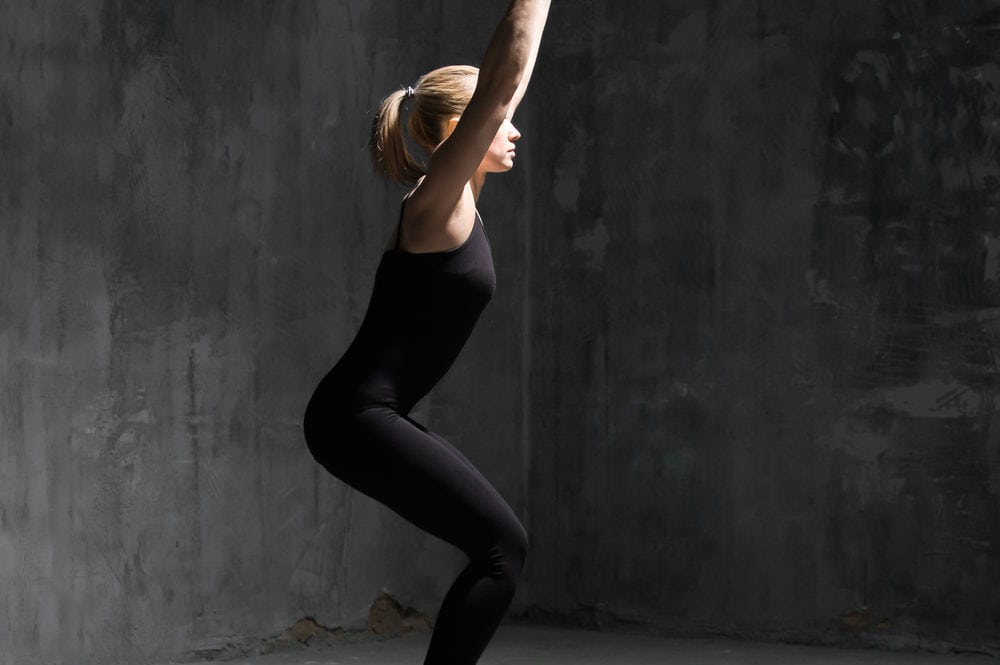
In this lesson, we present a number of cueing considerations for supporting healthy spinal and pelvic alignment.
Objective
Be familiar with considerations related to cueing for rib flare and misalignments of the spine and pelvis, taking particular care with the problem cues “tuck (or scoop) your tailbone” and “use a flat back.”
Description
Describe the typical intention behind the cue “tuck your tail” or “scoop your tailbone” and some potential problems with the cue. Explain the pelvic position that most students are likely to display and why an understanding of rib shear is of importance to yoga teachers. Explain why tucking the pelvis is likely to be an ineffective action for addressing hyperlordosis and provide verbal cues that can help students experience a healthier experience of their natural spinal curves.
Vocabulary
anteversion / anterior tilt, retroversion / posterior tilt, rib flare, tuck (or scoop) the tail
We thank yoga teacher Stephanie Patronis for research and writing contributions.

Please be sure you’re familiar with the following material.

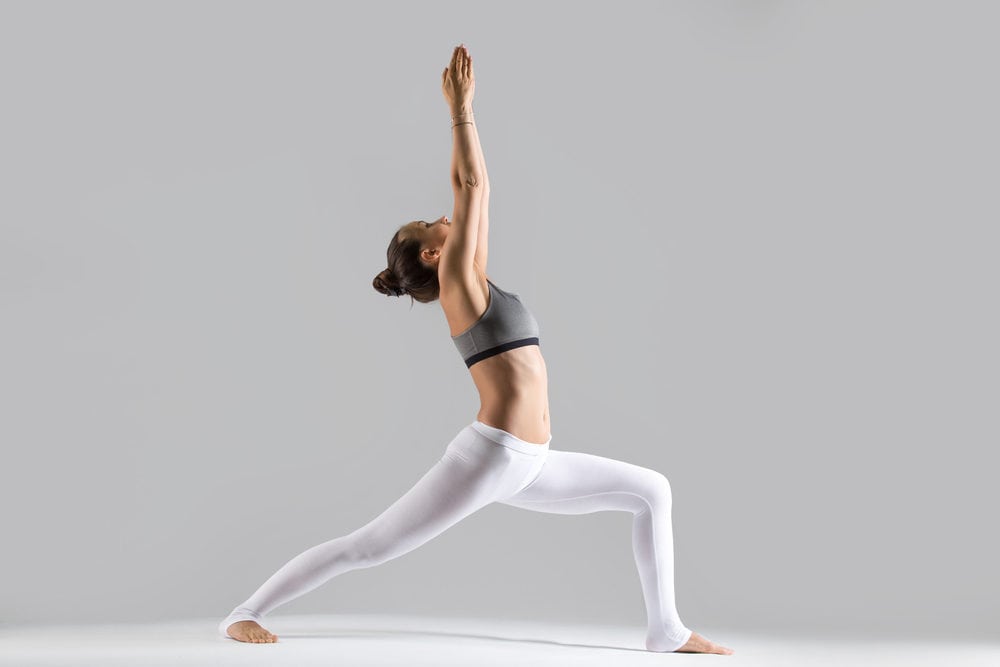
Here we examine the cues “tuck (or scoop) your tailbone” and to “use a flat back.” These cues were presumably invented to guide a student to find neutral spinal alignment.
Healthy Posture Features a Slight Forward Tip of the Pelvis & Sacrum & A Lower Back Curve
In a person with good, even posture… meaning appropriate spinal curves… the [pelvis and sacrum have] a slight forward tip on the leg bones, or “anteversion,” which can be seen from the side as the lumbar arch moving forward toward the navel. Esther Gokhale, a yoga teacher and anthropologist, has pointed out by looking at indigenous peoples and ancient sculptures of human posture, our balanced posture has a slight forward tip of the pelvis, and the sacrum and buttocks stick back a bit, in what she refers to as the “duck butt.” – Baxter Bell MD, Scooping the Tailbone? link
[See also: Anatomy of Spinal Curves and Healthy Posture and Postural Issues]
Teachers need cues to assist students who are overarching in the low back during particular poses, but “scoop the tailbone” and “use a flat back” are likely to be less effective than other options due to a number of potential issues.
Heagberg also notes this: “the over-arching was happening in the upper part of my lower back, so adjusting at the level of my pelvis didn’t make much difference.” Here she’s explaining that the “low back” (which is attached to the sacrum which is attached to the pelvis) is not just one simple, solid structure. It’s comprised of five vertebrae and multiple layers of core muscles. Thus, it’s unwise to automatically assume that a pelvic tilt will “fix” what’s happening in the complex structure we call the low back. In contrast, some teachers have tried various cues and approaches, observed the effects, and reported back on what often helps in various situations. See more below.
Many Interpretations
You’ve probably heard many a teacher say, “Tuck your tail,” in asana class, making it seem like a widely understood and accepted cue. But the phrase can be interpreted many different ways, often resulting in a chain reaction of unintended movement. We can tuck in a way that is efficient and effective, or in a way that leads to overwork and injury. – Amy Matthews & Leslie Kaminoff, Yoga Journal, Yoga Anatomy 101: Understanding Your Tailbone link
A Neutral and Stable Spine & Pelvis
For those students in a class who already have a neutral spinal position, the general cue “tuck your tailbone” may cause them to tuck the natural curvature right out of their low back so that they come into a posteriorly tilted pelvis, aka a “flat back.” I’ll be the first to admit fault for saying flat back in class all the time. What I really mean to say is neutral spine. A chronically posteriorly tilted pelvis is no better for the low back then an anteriorly tilted one. Both put pressure on the vertebrae, especially if you layer on complex muscular movement on top of these spinal positions (core work), and both turn off the very muscles needed to help maintain stability and equilibrium in your spine and pelvis. – Ashley Josephine Zuberi link
A More Nuanced Cue for the Rare Cases It’s Needed
What I often hear as a rationale for this cue and its variations are things like: releasing the low back, reducing the arch in the low back, or reducing too much anterior tilt in the pelvis. But, anatomically, do these reasons make sense? Generally, my answer to the question above is no. Think about it. We do backbends, right? The arch in your low back is maximized at that point. And of course, the lower back is designed to have a curve in it. Certainly, if someone has a very strong lordotic curve in their lumbar spine, then maybe you want to cue them to move towards a bit less curve. But that is specific to an individual, not something I’d recommend to everyone across the board as “right yoga alignment.” … [If you have a student in a group class who may benefit from this consideration,] make your cue more nuanced. It could be as simple as something like: “If you feel compression in your lower back, tuck your pelvis a little bit and see if that undoes it.” – David Keil, Yoganatomy, Yoga Alignment: Does It Really Matter? link
Students Have Different Personal Patterns
Many of my students sit at a desk all day BEHIND their sits bones in a posterior pelvic tilt (which I frequently call “sad tail”). As a result, their low back muscles often become weak and locked long. After work, they do “core” exercises… in spinal flexion with a posterior pelvic tilt… The result: Bypassing the engagement of the [deep core and obliques] and solidifying the dysfunctional postural position they live in all day… The reverse happens when you have too much of an anterior pelvic tilt or “happy tail”. I was in this category as a former gymnast and super flexible yogi… I would perform all of my daily activities in “happy tail” and then head off to yoga class and practice in the same pelvic tilt position. The result: Bypassing the engagement of the [deep core and obliques] and creating a myriad of repetitive stress injuries, overuse, and joint instability. As an embodied mover, make it your goal to enjoy the pleasures of all types of pelvic positions: Happy, Sad and Neutral. – Trina Altman, Yoga Tune Up, Happy Tail vs. Sad Tail: Which Way Do You Tilt? link
Harder to Engage Core
Directives like “Tuck the tailbone,” “Posteriorly tilt the pelvis,” “Flatten the back,” and their ilk are “not beneficial to the function of the spine”— and in fact make it harder to engage some of the core muscles that support the spine in neutral-spine poses and backbends. When you tuck the tailbone, “you activate the gluteal muscles, hamstrings, and hip rotators instead, and the multifidus and transverse abdominal muscles [spine stabilizing muscles] can’t activate,” says Reif. Reeducated by Reif, I now believe that a slight anterior (forward) tilt of the pelvis and a gentle curve in the lower back are optimal — not only in neutral-spine poses, but also when preparing for backbends. – Amber Burke, Yoga International, 8 Things I Mis-Learned in Yoga School link
Constantly Tucking Pelvis
The idea that a “tucked pelvis” is good for you comes from ballet… A tucked pelvis is necessary for a ballerina to perform her craft, but it is a decidedly unnatural movement to do all the time. Large numbers of ballet dancers end their careers with arthritic hips and sciatica due to this overemphasis on a tucked pelvis… Constantly arching the spine is unhealthy. Constantly tucking the spine is unhealthy. – Paul Grilley, Yoga Journal, Debunking the Tucked Pelvis link
Arched Low Back & Tucked Pelvis
I have a tendency to overarch my lower back. Growing up, my dance teachers constantly reminded me to “tuck your pelvis.” I tucked as hard as I could, but it never seemed to help. That’s probably, at least in part, because the over-arching was happening in the upper part of my lower back, so adjusting at the level of my pelvis didn’t make much difference. (Yes, it is entirely possible to have both an excessively arched lower back and a pelvis that is excessively tucked under… I highly recommend checking out this 2014 blog post by Jenni Rawlings, which explains a lot more about the biomechanics.) – Kat Heagberg, Yoga International, The 5 Alignment Cues that Had the Greatest Impact on My Practice link
Not Needed in Majority of Situations & When it Is, Try Draw the Tailbone Down
Let’s suffice it to say that I don’t see the need for additional instruction of scooping in the vast majority of situations. The exception to this general guideline occurs in yoga practitioners with a more exaggerated lower back arch… This is especially true if this situation results in pain in the lower back… In these cases, I will sometimes encourage the slight retroversion of the pelvis by suggesting… she should draw the tailbone down to the floor. This tends to create a bit less retroversion than “scoop the tailbone” might, and can still allow for the lumbar area to have a smaller version of its normal curve. If this action results in improved symptoms, I will have them practice it more regularly. – Baxter Bell MD, Scooping the Tailbone? link
More Judicious & Nuanced Approach
Beliefs about pelvis-tucking and lumbar flexion have moved from one end of the spectrum to the other in recent times… I am hopeful that our yoga community will settle on a more nuanced, less fear-based view of this issue in the near future. Our pelvis and spine and their adaptive, resilient tissues were designed to move in many different ways, and to keep these areas healthy and functioning well, we should move them in all of these ways on a regular basis. And when it comes to the specific yoga asanas that we teach or practice, we should let our anatomical intention for each pose — and not a one-size-fits-all rule — determine the pelvic positioning we teach. – Jenni Rawlings, Yoga & Movement, Pelvic-Tucking and Lumbar Flexion link
Students with SI Joint Issues May Respond Positively to the Cue
Some students find that some amount of tucking the tailbone alleviates pain or tension around the SI joints or low back. If students have something going on around their SI joints or lower back that is relieved by the cue to tuck the tailbone in yoga, then it suggests that their interpretation of that cue is taking them in a good direction for their practice. – David Keil, Yoganatomy, Should You Tuck the Tailbone in Yoga? link

I (Shelly) have particular appreciation for this image because it shows exactly how cueing in classes I attended led me to practice this pose.
I obeyed the instruction given to the whole class to tuck the tail, which surely made me look like this image and to feel as horrible as it appears to feel. It was the complete opposite of how I later came to effectively practice this pose.
I didn’t question the cue because if I didn’t tuck my tail, I could feel my glutes reaching way behind me (which is very common in weight lifting, and squats in particular, but felt unfamiliar in yoga) and what, at first, seemed to be a fairly strong arch in my low back. But if I would have disregarded the instruction and instead experimented with allowing my tail to reach back, I would have then been free to engage my core which immediately relieves any low back discomfort (which I experienced when I tucked, losing the ability to engage my core).
Tucking my tail did not put me in a neutral spine as this cue must have been designed to do for someone in some position at some time. Instead, it put me in the uncomfortable tucked position we see in this photo, reducing access to my core muscles and my glutes.
Later, when I let go of the counterproductive tucking (as shown by one of our models below), I was able to engage my core and feel comfort and strength in the pose, demonstrating a healthy expression of the pose for my body.
I went from disliking the pose to loving it!
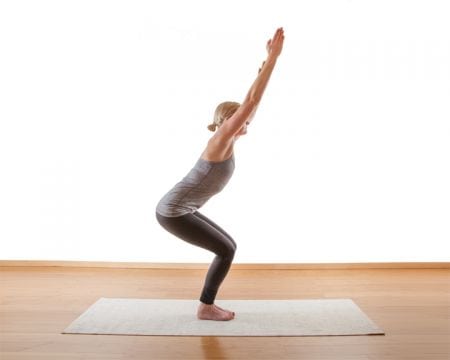
To help prevent situations where teachers are parroting cues without observing the actual effect on actual students, our asana digests are quite comprehensive. In Utktatasana Cautions, for example, you’ll see such support as the following:
Students with significant postural issues and/or muscular weaknesses may be better served by more preparatory postures:
Engage the glutes and reach them back. The effect should be an effort in the glutes as opposed to the low back.
Avoid encouraging students to tuck the tail which can take aware the ability to engage the glutes and core. It may be that they simply need to lesson the bend in the knees to the point where they can engage their core effectively.
Practice feeling the difference in your own body. Find the form that enables you to optimally engage your glutes and feel comfort in your back. Various students will respond to different cues based upon their tendencies, but be sure you know the feeling of good form in your body.
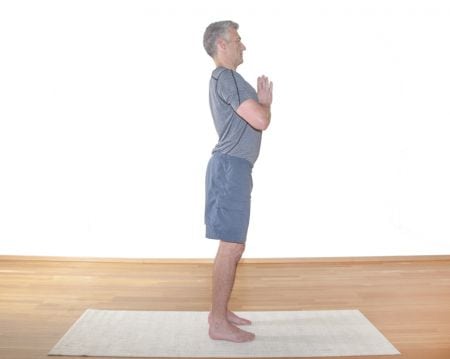
We feature these comments for more insight, and to provide links to sources for more information.
Usually an Unconscious “Cheating”
Flaring ribs [is usually referring] to a temporary dynamic state where a person may “cheat” by flaring their ribs to help with specific movements, such as reaching overhead. This compensation pattern is surprisingly common because it makes certain exercises feel easier. It also typically occurs when people lack the range of motion to complete exercises with correct form and technique. – Kenneth Leung, Built Lean, What is Rib Flare (& How to Prevent It) link
[Leung goes on to suggest practices to strengthen the core and stretch muscles that, when tight, can lead to rib flare. Includes diaphragmatic breathing, stretch for the chest, shoulder stretching, and others.]
Rib Flare & Anterior Pelvic Tilt
You may have noticed that a lot of people who practice yoga have… lost their thoracic curve, and they stand with a rib flare and an anterior (forward) pelvic tilt. Typically with this type of posture, the spinal extensors are overworking and hypertonic, while the spinal flexors are underutilized and weak. When we have this particular muscular imbalance, we tend to experience muscle spasms at the TL junction, as well as neck and low back pain, because these areas of the body are being compressed. That compression manifests as hyperextension at the TL junction or low back, which is further exacerbated in extension poses, such as cobra, upward facing dog, and wheel. – Trina Altman, Yoga International, Why We Shouldn’t Demonize Thoracic Flexion in Yoga link
Different Poses & Situations May Call For Different Approaches
[For those who have a tendency to flare the low ribs,] the cue [to knit the ribs] can help create a more neutral posture, encouraging light abdominal engagement and reducing lumbar extension. If, however, we don’t tend to flare our ribs, the cue could trigger excessive abdominal engagement and make it more difficult for the low ribs to move to allow for full, free breathing. The situation is a little different in backbends, or spinal extension… When we try to deepen a backbend, the tendency for many of us is to exploit lumbar range of motion rather than capitalizing on the smaller extension capacity of the thoracic… The cue to “knit the low ribs” can help us share the pose between our lumbar and thoracic spines and our shoulders—maximizing the benefits to each. [See article for in-depth considerations.] Some of us will feel more balanced between front and back body when we gently draw the ribs in and down, while others will feel best in their starting position, and still others will benefit from letting the ribs expand slightly. – Rachel Land, Yoga International, 5 Common Yoga Cues Translated link
You can skip over this section; you need only consult the information in the previous two sections (Tuck / Scoop Tailbone and Rib Flare). The quotes below are here simply to keep a record of this exchange, which lends insight into how mistakes and overgeneralizing can be widely shared, leading to an increase in misunderstanding.
Ribs Forward Indicating Over-Arched Lower Back
The ribcage puffing forward is what most teachers’ eyes see first, so they say, “soften your front ribs” in an attempt to get students to drop the front of the ribcage toward the pelvis. But the change actually comes from the front of the pelvis, the hips. To fix over-arched lower backs and pointy, puffy lower ribs, students have to posteriorly tilt their pelvis at the hip joint bringing their pelvis and lower back into neutral alignment. That reduces the lower back’s arch and shortens the front body, dropping the ribs down. – Alexandria Crow, Yoga Journal, Alignment Cues Decoded: “Soften Your Front Ribs” link
Rib Thrust Often Causing Hyperlordosis — Not a Result of It
Alexandria implies in her article that most people have a forward-tilted pelvis (also called an anterior pelvic tilt), which needs to be brought back to neutral with a posterior tilt, or tuck. But the anatomical truth is that the overwhelming majority of us present with a pelvis which is actually tucked under (also called posteriorly-tilted)… In addition to having a tucked pelvis, most people also present with a forward translation of their rib cage, also called rib thrust or rib shear. When one’s rib cage has moved forward, it creates the overly-arched spine… but the mistake that too many yoga teachers make is in assuming that this excessive arch is coming from below – from the pelvis. – Jenni Rawlings, A Biomechanics-Informed Response to Yoga Journal: We Do Not Need to Tuck Our Tail in Every Yoga Pose link
Spinal flexion (forward bending) is contraindicated for some conditions. For everyone else, spinal flexion is simply one of six spinal movements that should be regularly practiced.
There is a very real alignment consideration around forward bending, but this has to do with pelvic tilt as opposed to the action of forward bending itself.
But there seems to be an overgeneralization among some that has led to fear around forward bending, and the use of cueing that is unnecessarily restrictive. Please see Asana Category: Forward Bending for a comprehensive list of contraindications, plus detailed teaching on practicing spinal flexion. You’ll see in the section on Pelvic Tilt that it’s usually recommended to begin with the pelvis in anterior tilt and then allow it to move into posterior tilt.
Avoiding Overgeneralizations
Not all spines are created equal and not all spines have received the same degree of stress and/or injury in their lifetimes. For some injuries and conditions, spinal flexion may be contraindicated. And I believe this has perpetuated throughout the yoga world to make many yoga teachers believe that because spinal flexion is not advised for some parts of the population, that means it is not advised for all. However, this could not be further from the truth. Spinal flexion is a healthy and normal movement for the spine and it should be practiced as a healthy and normal movement rather than demonized as something “dangerous” or “incorrect.” – Leah Sugerman, YogaUOnline, Rounding the Spine in Yoga: Why Spinal Flexion Isn’t Necessarily a Bad Thing link
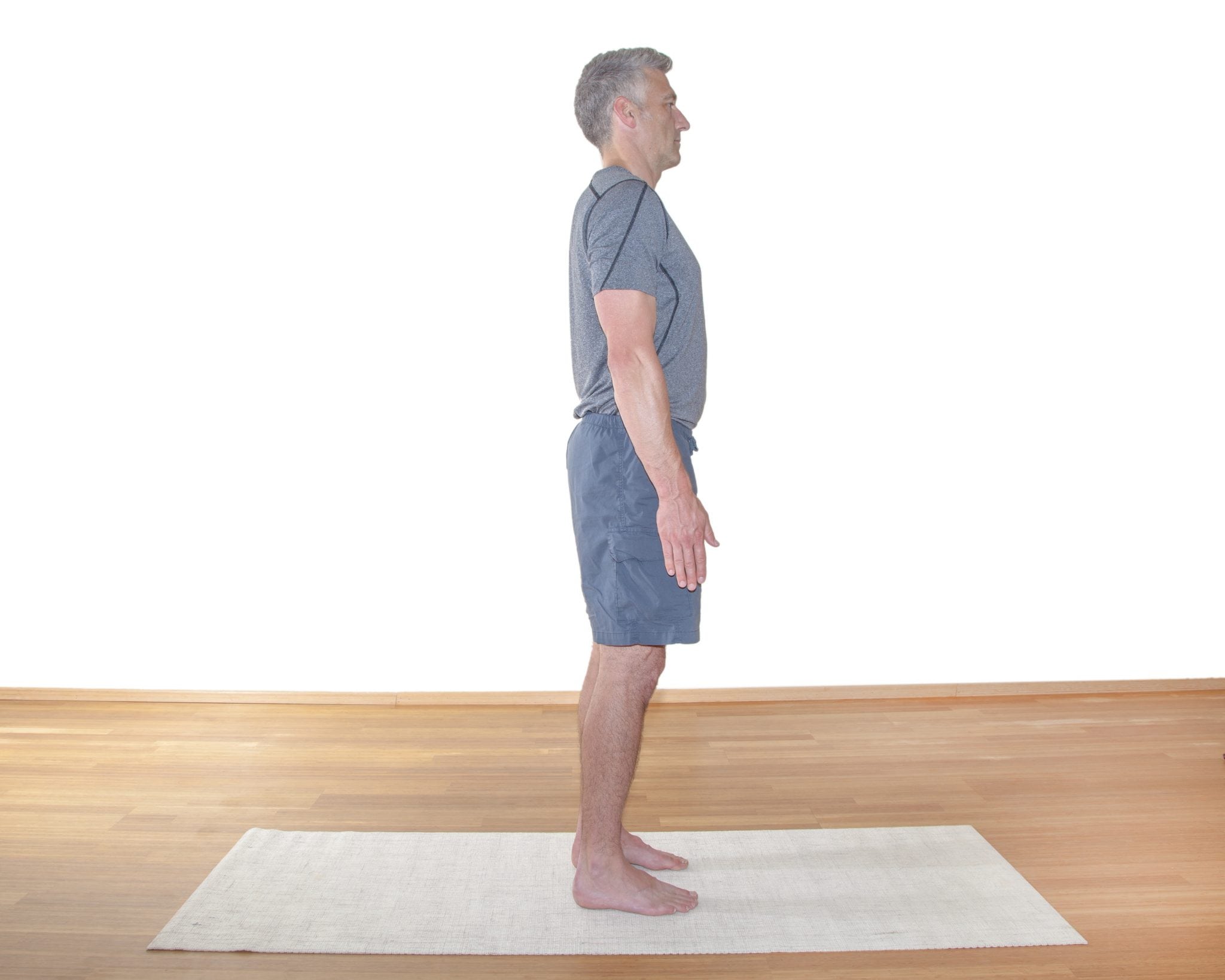
This list of cues for finding neutrality in the spine and pelvis can give you ideas for how to meet particular needs in various poses with various students.
See also: Teaching Anatomy of the Spine & Healthy Posture
Gradual Abdominal Contraction & The Corset
When you do a Cat-Cow movement and round your back on exhale, once again you are pulling the belly button in toward the spine which will result in your tailbone tucking under… [This is an] example of when tucking the tailbone under is a natural result of a progressive abdominal contraction that initiates a posterior pelvic tilt. It makes sense then to direct your student’s attention to the gradual abdominal contraction rather then the tailbone tucking, even though those two go hand in hand. This can be an excellent teaching tool to build student’s awareness about the relationship between the pelvis and the spine. The corset, on the other hand, means hugging the waist in toward the center as if you were tightening an invisible corset around your torso. It is a similar action of progressive abdominal contraction, but here no visible change occurs in the position of your pelvis and the lower back remains neutral. This is a preferable method for creating and maintaining stability in your core and is useful in any yoga posture… Once the students grasp the idea of progressive abdominal contraction, it is a good idea to make a habit out of engaging the abdomen with every exhalation when you practice. – Olga Kabel, SequenceWiz, Corset vs Pelvic Tilt: To Tuck or Not to Tuck the Tailbone Under link
[See the article for more information and images.]
Explaining “Tilt Your Pelvis”
Picture your tailbone as sitting directly between [your] two hipbones, but set a little further back. This gives you a mental picture of the triangle of your pelvis. This is useful if you’re in Staff pose, for example. To get deeper into the pose, instead of bending and rounding from the lower back, picture your whole pelvis tilting forward, decreasing the angle between the lines of your belly and your legs. Tilting your pelvis as a whole in this way gives you deeper access to many poses. – Maren Hunsberger, DoYouYoga, 7 Yoga Alignment Cues Explained link
Return Rib Cage to Neutral
The overwhelming majority of us present with a pelvis which is actually tucked under (also called posteriorly-tilted)… In addition to having a tucked pelvis, most people also present with a forward translation of their rib cage… When one’s rib cage has moved forward, it creates the overly-arched spine [often seen in] students, but the mistake that too many yoga teachers make is in assuming that this excessive arch (also called hyperlordosis) is coming from below – from the pelvis… The hyperlordosis that we all-too-often see in our students isn’t the result of a pelvis that is anteriorly-tilted from below — it’s the result of a rib cage that has sheared forward from above. The fix is therefore not to tuck your pelvis under… The correct fix is to return the rib cage to neutral. – Jenni Rawlings link
In Some Cases: Chest or Heart Up & Ribs Down
When you contract your abdominals, they help keep your ribs down and in place. You should be able to do this action without flexing your spine, since the spine should always be in neutral when doing strengthening exercises. A great cue to keep in mind when you’re exercising is “chest up and ribs down”. – Kenneth Leung, Built Lean, What is Rib Flare (& How to Prevent It) link
Cue for the Cervical Spine (Neck)
It’s easy to get a sore neck these days, especially while driving… It is common to strain the chin forward, and thus take the neck out of alignment… Bring your index finger to your chin and gently press your head back. This small movement will help to open up the back of the neck, and stack the vertebrae of the spine in proper alignment. – John Sovec, YogiTimes, 10 Tips to Strengthen Your Yoga Practice link
We provide dozens of verbal cues to consider for each asana. For more information see:
Aligning Cervical Spine & Head
“Back of head in line with back of pelvis (or tailbone)” is my quick “go-to alignment check” in poses like Tadasana (Mountain Pose); Downward Facing Dog; and when setting up for backbends, forward bends, and twists. And it’s particularly useful when I’m taking or teaching a faster-paced class in which there’s not a ton of time to delve into alignment. Plus it sets the stage for exploring other aspects of head/neck alignment—like leading with the chest (not the chin!) and allowing the head to follow in backbends, comfortably turning the head to look upward in poses like triangle and side angle. – Kat Heagberg, Yoga International, The 5 Alignment Cues that Had the Greatest Impact on My Practice link

We offer a precise progression of lessons to support training, research and study on the subjects of pelvic anatomy, hip issues and practices to prevent and support students with hip pain. The lessons are presented within these modules:
We hope you found this excerpt from our Member site useful and inspiring. The Asana section on the Member site is extensive and includes such tools and resources as: